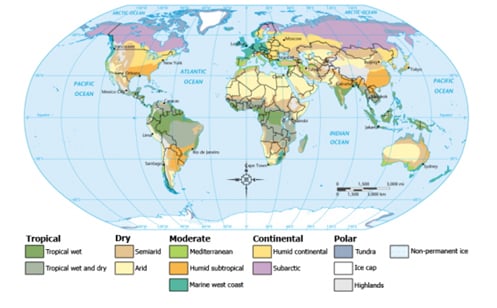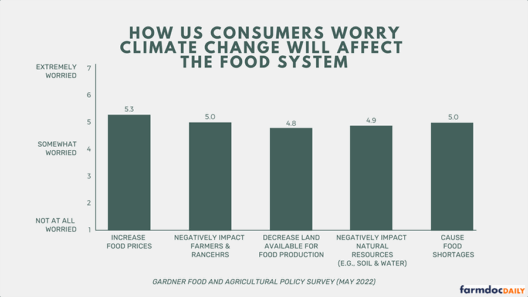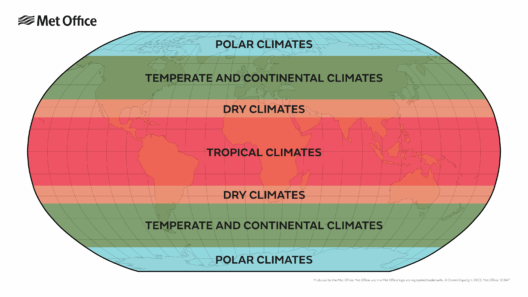Understanding your climate zone is crucial in addressing your daily activities, agricultural pursuits, and even your home’s design. Climate zones are areas of the world that share similar weather conditions, primarily influenced by latitude, topography, and proximity to water bodies. Thus, an exploration into the various climate zones can unveil fascinating insights beyond mere weather patterns.
Firstly, let’s delineate what constitutes a climate zone. At a fundamental level, these zones are categorized based on temperature, precipitation, and vegetation. The most widely accepted system is the Köppen climate classification, which divides the globe into several primary groups: tropical, dry, temperate, continental, and polar climates. Each of these broad categories has subcategories that can further refine our understanding of local climatic conditions.
When individuals ponder their climate zone, they often think of the temperature and general weather patterns they experience throughout the year. However, the deeper fascination lies in how these climatic conditions mold local ecosystems and influence human behavior and infrastructure. The lush rainforests of the tropical zone, for example, sustain a tremendous variety of flora and fauna, whereas the arid deserts present starkly different visual landscapes, shaping both local wildlife and human survival strategies.
As one examines the tropical climate, it becomes evident that this zone exhibits warm temperatures year-round, coupled with a high incidence of rainfall. This environment fosters biodiversity and rich vegetation but also leads to challenges such as flooding and the spread of tropical diseases. As a result, inhabitants have adopted various adaptive strategies, such as elevated buildings and sophisticated water management systems. Conversely, in the dry climate zones, characterized by minimal rainfall and majestic dunes or rocky terrains, residents rely heavily on ingenuity regarding water conservation, selecting drought-resistant crops and adopting sustainable agricultural practices.
Transitioning to temperate climate zones, one observes a stark contrast. These regions typically reflect four distinct seasons: a warm summer, a cool autumn, a cold winter, and a rejuvenating spring. The seasonal variability not only enriches the aesthetic appeal of these areas but also influences local festivals, agricultural cycles, and even economy-driven tourism. Consider the lush fall foliage of New England attracting tourists—this climatic phenomenon directly correlates with the weather patterns that delineate the temperate zones.
Within the temperate climate zone, one can further illustrate the subcategories. The Mediterranean climate, for instance, displays distinct wet and dry seasons and is noted for its mild weather and thriving agriculture that significantly contributes to local economies through the cultivation of olives, grapes, and citrus fruits. The intricate balance of climate, soil, and local flora forms a unique ecosystem that is both beautiful and viable for human life.
In contrast, the continental climates, characterized by stark temperature variations, can present extreme winter and summer conditions, shaping infrastructure decisions and lifestyle adaptations. Home heating systems are paramount in these regions, whereas air conditioning takes precedence during sweltering summers. These adaptations illustrate humanity’s remarkable ability to adjust to climatic demands while emphasizing the importance of understanding one’s climate zone.
Lastly, the polar climates encompass some of the most inhospitable environments on Earth. Despite the frigid conditions, life persisting in these regions showcases the resilience of ecosystems and human ingenuity. The flora and fauna of polar areas have adapted significantly to survive harsh winters, and the indigenous cultures reflect profound knowledge about their environment, illustrating a delicate balance between human activity and natural ecosystems. Studying these climate zones provides essential insights into the impacts of climate change, as they tend to show rapid alterations in weather patterns.
In light of climate change, understanding one’s climatic zone is not merely academic; it is essential. The increasing incidence of extreme weather events, shifting agricultural patterns, and rising sea levels clearly denote changing climates. For those in coastal regions, an awareness of rising tides and stronger storms may push communities toward fortifying infrastructures or even reconsidering habitation zones. Meanwhile, those in temperate zones might find their agricultural cycle disrupted as planting and harvesting seasons shift, necessitating adaptation that embraces innovative agricultural technologies and practices.
Moreover, the fascination with climate zones extends beyond practical implications; it also involves cultural and personal identity. Regions naturally shaped by their climate produce distinct cultural expressions, culinary traditions, and lifestyle practices that foster regional pride and community cohesion. This interplay between climate and culture serves to deepen our appreciation of both the environment and human creativity.
In conclusion, discerning your climate zone requires more than a mere glance at weather statistics; it necessitates an appreciation of the intricate webs of interactions between climate, geography, and human existence. Each climate zone, from the tropical to polar, holds within it stories of adaptation and resilience, echoing the themes of survival and sustainability that resonate deeply in today’s world. Engaging with these concepts fosters a greater understanding of our place within our climate zones and encourages proactive measures in responding to the pressing challenges posed by climate change.







